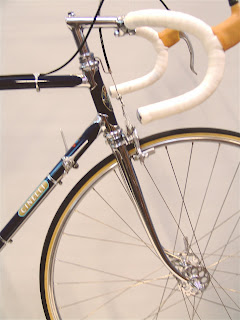When I started bike racing in 1954 there were three governing organizations for the sport in Britain: the Road Time Trials Council (RTTC) administered almost all the time trials in the country: the National Cyclists Union (NCU) controlled all track racing and circuit racing which was usually on disused wartime airfields. An upstart group, the British League of Racing Cyclists (BLRC), was formed in the forties to promote continental style massed start racing on the open road. Until the BLRC came along massed start racing on the open roads was effectively banned in Britain and had been since the turn of the century. The founders of the League discovered that there was no law preventing bike racing on the open roads so within a short time they were organizing major races all around the country.
This caused a big split in the cycling community. The BLRC members felt that the NCU was holding the sport back and the NCU members felt that the BLRC would bring the end to all organized racing. Anyone that joined the BLRC (the League) was banned from riding NCU races. The Union was the only organization recognized by the UCI therefore anyone with any hope of riding for Britain was forced to race Union events.
League members tended to be young, keen on all things continental and fervent jazz fans. If two opposing groups of cyclists passed on the road a cry of “up the League” came from the League group, which attracted a rather obscene response from the Union side.
Although I started my cycling with a Union club I was attracted to the League, I was young, Coppi was my hero, the Continent was where the sport's greatest moments unfolded and I was beginning to become interested in jazz. Each month I would wait anxiously for the latest edition of the “Leaguer”, the official magazine of the organization. It was delivered to my home by John Gough a devout Leaguer himself who pedaled around our area dropping off copies to all fellow League disciples.
John rode a wonderful Cinelli, which was a very unusual bike in London at that time. Most of us rode local built bikes, Claud Butlers, Holdsworths, Allins, Algurns and in my case a very nice Stuart Purves. All were good bikes but the Cinelli that was so much more attractive. The first time John arrived at the house the bike was fitted with a Campag Corsa derailleur. It was an outstanding machine. He had the bike custom built in 1951 with the special Campag Corsa drop-outs. On each of John’s monthly visits I drooled over the Cinelli. He was even good enough to let me ride it and attempt the intricacies of changing the Corsa derailleur.

John Gough with the Cinelli, fitted with a Campag Gran Sport derailleur, 1952

John Gough competing in the Coulsdon-Brighton Time Trial on the Cinelli, with a Campag Corsa derailleur. 1951
.jpg)
Changing gear on the Cinelli, now fitted with a Campag Paris-Roubaix derailleur and painted blue. 1955

Mike Barry racing on the Cinelli, Chobham England, 1956
Then on one visit John said he wanted to sell the frame. I jumped at the opportunity to buy it and put the Purves aside and used the Cinelli for all my racing.
One time while carrying the bike to a race on an improvised rack on the back of my Lambretta motor scooter, I hit a pot hole in the road and with a loud crack the right hand chainstay broke. It was more a problem with my rack design than with the frame. I had it repaired but a few years later I found a new Cinelli irresistible and the old one was put aside.
I kept the old frame and eventually brought it to Canada and rode it until the seat tube and bottom bracket cracked. I repaired it and had it repainted but unhappy with the paint job I never rode it again. It hung on a hook in the workshop waiting for the day when I would get it restored properly. Recently (twenty five years later) I took it down, had it rechromed and gave it to Noah (Velocolour) to refinish the way it was when I raced it fifty years ago. It had been beige in 1951 when John bought it but he had had it repainted dark blue by the time I got it. There has been some discussion as to which colour it should be now and eventually I decided on the blue. I imagine many Cinelli enthusiasts will be aghast that I didn't have it repainted in the original biege but I wanted it how I remembered it.

Mike Barry competing on the Cinelli in the Ranmore Hillclimb, 1958
It is now built up with almost the same components as it had in 1958. Some parts are the actual ones I used then. I think it looks better now than it ever did thanks to Noah’s paint job.

The Cinelli today

Campagnolo Corsa/P-R drop-outs, Gran Sport derailleur

Cinelli steel "bars and stem, Mafac brakes with Universal levers, Campag Gran Sport hubs

Stronglight steel cranks, TA Adapteur chainrings


Noah Rosen of Velocolour did a great job with the restoration. His attention to detail is second to none. You can see more of his work at: velocolour.com


